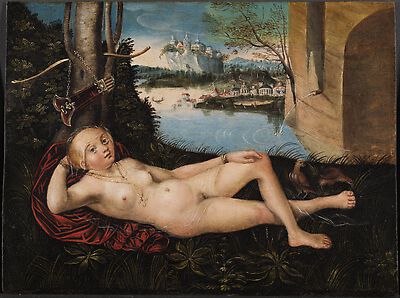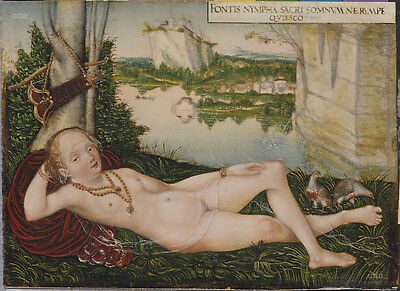Reclining Nymphe
Lucas Cranach the Elder, alongside Albrecht Dürer, was one of the pioneers of nude painting in Germany. In 1509 he painted a life-size figure of a standing and completely unclothed Venus with Cupid. About six years later there followed a reclining nude figure – the nymph reclining in natural surroundings. Cranach and his workshop assistants repeated both motifs – the Venus and the nymph – in different versions. [1] In the years after 1530 these can be defined as a serial production even if the versions are rarely identical. For the most part the pictorial elements were skillfully modified and combined in a new way. The Reclining Nymph from Karlsruhe shown here is so similar to the earlier versions in New York and Kassel, which are attributed to Lucas Cranach the Younger, that it may be deemed a copy.[2] The centre is occupied by the nude nymph with a transparent veil over her head and vulva. The golden necklace and the bracelets appear more suited to a court lady of Cranach’s time rather than a Goddess of nature. The bow and the quiver full of arrows indicate that the nymph belongs to Diana’s entourage – the Goddess of hunting. At the same time they also recall the weapons of Cupid, the companion of Venus. The partridges at the nymph’s feet, which were a popular prey, also refer to the hunt. They can also be interpreted as an erotic allusion, as according to contemporary views they were particularly unbridled.[3] In mythology nymphs have the reputation of being very chaste, so the partridges cannot be interpreted as an attribute of the reclining figure, but rather as a warning to the viewer with his coveted gaze. In the middle ground water flows from a fountain spring into a pond, behind there is a rocky outcrop with a castle and a fantasized city lies below.
The painting from Karlsruhe is different from most of the other known versions of this subject in the respect that it is very small and painted on metal. This is a painting for a private cabinet, which does not serve a representative purpose, but rather the close-up view should elicit aesthetic appreciation and erotic thrill. The nymph is shown particularly child-like, even dollish and far removed from the ideal body image developed by Albrecht Dürer. Despite the mythological subject there is little trace of the renaissance enthusiasm for antiquity.
The gradual removal from nature on the one hand and the classical prototypes on the other was a tendency of Cranach’s which he passed on to his sons and assistants. However the almost naïve stylisation in the present work suggests that it is not from the Cranach workshop, but rather by a follower from the late 16th or early 17th century. The painter valued the direct eye contact between the nymph and the viewer: unlike in Cranach paintings the beauty looks with wide open eyes out of the image. As such it counteracts the meaning of the epigram, which can be read in the inscription on numerous other paintings of nymphs – the request not to wake the nymph. [4] The inscription can be found on the painting from Karlsruhe in the upper right corner. However it is only revealed in the infrared reflectogram, because it was overpainted at a later stage. The fact that the nymph is wide awake may have prompted this.
Holger Jacob-Friesen
[1] Only a few are listed and illustrated in: Max J. Friedländer/Jakob Rosenberg: Die Gemälde von Lucas Cranach, Basel, Boston, Stuttgart 1979, No. 119, 120, 259, 402, 403.
[2] See: The Metropolitan Museum of Art, New York/The Robert Lehman Collection, Bd. 2: Fifteenth to Eighteenth-Century European Paintings, New York 1998, No. 10, 48-54; Bernhard Schnackenburg: Staatliche Museen Kassel/Gemäldegalerie Alte Meister. Gesamtkatalog, Bd. 1 (Text), Mainz 1996, No. GK 19, 97.
[3] See: Franz Matsche: „Nympha super ripam Danubii“. Cranachs Quellnymphen und ihr Vorbild, in: Andreas Tacke (Hrsg.): Lucas Cranach 1553/2003. Wittenberger Tagungsbeiträge anlässlich des 450. Todesjahres Lucas Cranachs des Älteren, Leipzig 2007, 159-203, (194f.)
[4] „FONTIS NIMPHA SACRI SOMNVM NE RVMPE QVIESCO“ – Ich, die Nymphe der heiligen Quelle, ruhe, störe nicht meinen Schlaf.

